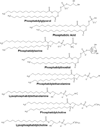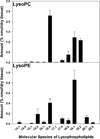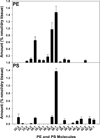Glycerophospholipid analysis of Eastern red bat (Lasiurus borealis) hair by electrospray ionization tandem mass spectrometry
- PMID: 24532214
- PMCID: PMC4167415
- DOI: 10.1007/s10886-014-0388-2
Glycerophospholipid analysis of Eastern red bat (Lasiurus borealis) hair by electrospray ionization tandem mass spectrometry
Abstract
Pilosebaceous units found in the mammalian integument are composed of a hair follicle, the proximal portion of the hair shaft, a sebaceous gland, and the erector pili muscle. Pilosebaceous units release protective oils, or sebum, by holocrine secretion onto skin and hair through rupturing of sebocytes. Sebum is composed largely of polar and neutral lipids including glycerolipids, free fatty acids, sterols, wax esters, sterol esters, and squalene. In addition to these lipid classes, there is a small proportion of ionic/anionic glycerophospholipids (GPs). Composition of GPs on hair is rarely addressed despite their broad biological activities as signaling molecules and membrane stability. Furthermore, knowledge on GP composition in bats is lacking. Bat GP composition is important to document due to GP roles ranging from decreasing drag during migration to interaction with the integumentary microbiome. In this study, we analyzed GP molecular composition with liquid chromatography electrospray ionization tandem mass spectrometry and compared GP content to previous literature. A total of 152 GPs were detected. Broad GP classes identified include lysophosphatidylcholine, phosphatidylcholine (PC), lysophosphatidylethanolamine, phosphatidylethanolamine, phosphatidylinositol, phosphatidylserine, phosphatidic acid, and phosphatidylglycerol, with PC being the most abundant class. The acyl components were consistent with fatty acid methyl esters and triacylglyceride moieties found in Eastern red bat sebum. Glycerophospholipid proportions of the hair surface were different from a previous study on bat lung surfactants. This study determined the broad class and molecular species of bat sebum GPs that may be used in future ecological studies in vespertilionid bats.
Figures






References
-
- Aktas M, Wessel M, Hacker S, Klüsener S, Gleichenhagen J, Narberhaus F. Phosphatidylcholine biosynthesis and its significance in bacteria interacting with eukaryotic cells. Eur J CellBiol. 2010;89:888–894. - PubMed
-
- Arouri A, Mouritsen OG. Membrane-perturbing effect of fatty acids and lysolipids. Prog Lipid Res. 2013;52:130–140. - PubMed
-
- Barclay RMR. The effect of reproductive condition on the foraging behavior of female hoary bats, Lasiurus cinereus. Behav Ecol Sociobio. 1989;24:31–37.
-
- Blehert D, Hicks AC, Behr M, Meteyer CU, Berlowski-Zier BM, Buckles EL, Coleman JTH, Darling SR, Gargas A, Niver R, Okoniewski JC, Rudd RJ, Stone WB. Bat white-nose syndrome: An emerging fungal pathogen? Science. 2009;323:227. - PubMed
-
- Brooke AP, Decker DM. Lipid compounds in secretions of fishing bat, Noctilio leporinus(Chiroptera: Noctilionidae) J Chem Ecol. 1996;22:1411–1428. - PubMed
Publication types
MeSH terms
Substances
Grants and funding
LinkOut - more resources
Full Text Sources
Other Literature Sources

